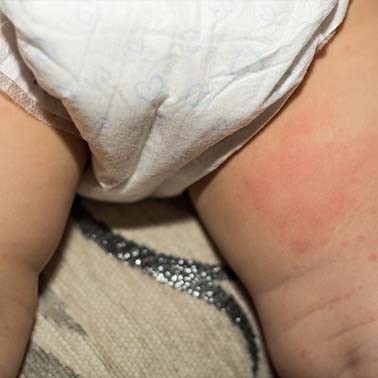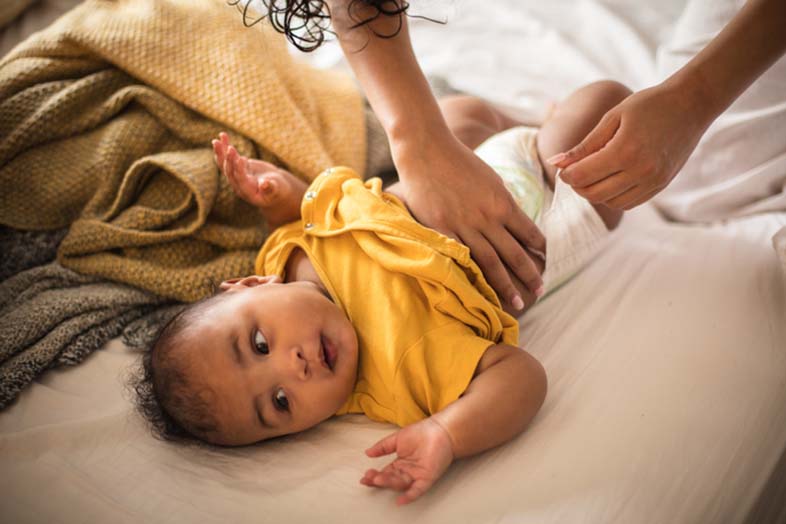From wetness to food sensitivities, we asked midwife Kate Mundell of Naytal Midwives to explain the most common causes of nappy rash and how to prevent and soothe it. In thisguide, we will take you through:
- What is baby nappy rash?
- What does nappy rash look like?
- What causes nappy rash?
- How long does nappy rash last?
- How to prevent nappy rash
- How to treat baby nappy rash at home
- What is fungal nappy rash?
- When should you see a doctor?
What is baby nappy rash?
The term ‘nappy rash’ is used to refer to an acute inflammatory reaction of your baby’s skin in the area underneath the nappy.
What does nappy rash look like?
The signs of nappy rash that most people would recognise is an area of angry, red skin (also called erythema) in the nappy area. There may be defined spots, or there may be larger red patches of skin. You might also see blisters, pimples, or spots.
Nappy rash can range in severity from a very slight redness through to an incredibly red, sore, and angry skin inflammation. This can cause distress to your baby, as the rash feels painful and itchy.
What causes nappy rash?
Midwife Kate Mundell says: “The barrier function of your baby’s skin can be harmed because it is in constant contact with wet, acidic urine, which softens and breaks down the skin if left unchecked. “ But it’s not just nappy care that can cause nappy rash," as Kate explains. Medication, teething, and food can also contribute.
Common nappy rash causes:
- The friction of a nappy or other fabric rubbing on the skin. Ill-fitting cloth nappies could cause some irritation.
- The skin being in contact for too long with your baby’s poo.
- The nappy area is not being cleaned often or thoroughly enough.
- Using harsh, alcohol-based wipes. Instead, use gentle wipes such as Huggies® Extra Care Sensitive.
- Medication, such as antibiotics, can often result in a nappy rash.
- Changes to your baby’s diet can be a trigger. It’s normal to see nappy rash during weaning as a result of new foods, particularly acidic fruit.
- Teething often causes a flare up in sore bottoms. This is due to excessive saliva produced by babies during this time.
How long does nappy rash last?
“If you start managing the symptoms of nappy rash quickly and get it under control, the rash should usually disappear within about three days,” says Kate. “Complicating factors, such as antibiotic use and allergies to certain foods may cause it to last a little longer.”
How to prevent nappy rash
Prevention is preferable to treatment — but this is easier said than done at times! You can never know for sure what will trigger a nappy rash case for your baby. Try to keep your baby as clean and dry as possible, change their nappy frequently and if you notice a sensitivity with a particularfood, avoid it for a little while.
If your baby has mild redness on their skin, you can use a barrier cream, such as Metanium Nappy Rash Ointment at each nappy change to protect the skin.

How to treat nappy rash at home
A good routine is often key to preventing and treating nappy rash. Follow our step-by-step guide to help keep nappy rash at bay. We asked midwife Kate for her top nappy rash treatments you can do at home:
-
Try using a higher absorbency nappy. Disposable nappies have higher absorbency than reusable cloth nappies. If you’re using cloth nappies and if your baby develops a rash, switching temporarily to disposable can help keep them dry during healing time.
-
Allow your baby some time without a nappy on to allow air to get to the skin. For nappy-free time with minimal cleanup, lay your baby on a blanket or a washable play mat.
-
Make sure you change your baby's nappy frequently, even if it isn’t soiled — especially in warmer weather.
-
Change your baby’s nappy as soon as it is soiled, and frequently if wet.
-
Choose fragrance and alcohol-free baby wipes such as Huggies® Extra Care Sensitive.
-
After a bath or nappy change, avoid rubbing your baby dry; instead, use a gentle, patting motion with a clean towel
-
It’s okay to bathe your baby daily, but avoid using perfumed soaps, shampoos, and body washes.
-
A Zinc and Castor Oil ointment BP or a soft white paraffin BP ointment is recommended to treat more severe nappy rashes.
-
Don’t use baby powder as this can be irritating.
Following these steps will probably clear the rash in about three to four days.
What is fungal nappy rash?
“If you can see red, raised patches surrounded by scales, especially in the folds of the skin, which may have small, raised cysts or fluid-filled blisters and you have tried all your usual home remedies for nappy rash, your baby may have a fungal infection,” says Kate. “This is caused by a harmless yeast (candida) that lives on the skin. It can be treated with an antifungal nappy rash cream, so speak to your doctor if you suspect this is the cause of your baby’s red, uncomfortable skin.”
When should you see a doctor?
“In most cases,” says Kate, “nappy rash cases are mild and can be easily treated at home by you. Home remedies, strategies, and an appropriate barrier cream will typically clear the rash quickly.
“However, if this doesn’t work, you’ll need to speak to your GP or health visitor. If the rash is inflamed and your baby is in pain, they could be prescribed a topical hydrocortisone 1% cream. This is applied to the skin once a day for a week and is used as well as a barrier cream until the symptoms settle down.”
If your baby appears unusually grumpy, listless, and perhaps has a slight fever, their nappy rash might be infected. If this is the case, make sure you visit your GP as soon as possible for an antibiotic to clear the infection. You can find out more about nappy rash on the NHS website.
With thanks to Kate Mundell of Naytal Midwives
Wipe with love and care
We understand that those early days of parenting can feel magical and stressful at the same time. We’re here for you. Huggies® have been helping parents clean, wipe and care for their little ones for years. Lean on us for help with newborn skincare.


 your parenting partner
your parenting partner